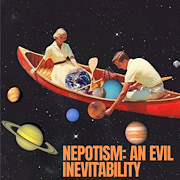|
Dalael posted:We know for a fact that a or multiple asteroid/comet/whatever hit the ice caps around 12 000 years ago. The evidence is undeniable and in 2018 a 21miles side crater was found under the ice which so far everything points to having been made at that time. Ah poo poo it’s Bolivian Atlantis time of year already?
|
|
|
|

|
| # ? May 25, 2024 11:54 |
|
There were huge glacial outburst floods at the end of the ice age. Melting glacier water gathered in ice dams and when the dams burst, there were global effects. https://en.wikipedia.org/wiki/Missoula_floods They get blamed for flood myths, climate change, megafauna extinction etc.
|
|
|
|
Vincent Van Goatse posted:An asteroid of the size needed to make that crater would not be large enough to cause the ridiculous global flood scenario you described. An asteroid that can punch a 21 miles wide crater under what was miles of ice would definitely cause massive amount of melting. Its strongly suggested this may be what caused the YDB and I doubt you have even a close understanding of the massive amount of energy released to create that kind of crater.
|
|
|
|
Dalael posted:An asteroid that can punch a 21 miles wide crater under what was miles of ice would definitely cause massive amount of melting. Its strongly suggested this may be what caused the YDB and I doubt you have even a close understanding of the massive amount of energy released to create that kind of crater. You're massively underestimating how much melting would be needed to raise global sea levels to their current level from what they were 12,000 years ago. Never mind that it's very well known not to have been an instantaneous event.
|
|
|
|
There's quite a bit of ocean around though. What's the global sea level rise from adding a couple hundred cubic miles of water?
|
|
|
|
Vincent Van Goatse posted:You're massively underestimating how much melting would be needed to raise global sea levels to their current level from what they were 12,000 years ago. Never mind that it's very well known not to have been an instantaneous event. I'm not saying it would have been instantaneous, but the massive heat would have melted millions if not billions of tons of ice and then the runaway melt from such an event would have lasted years. This ain't me suggesting this poo poo, its a bunch of scientists who are working on this project and are convinced this is one of the major event of the YDB. https://www.pnas.org/content/104/41/16016 https://www.sciencemag.org/news/2018/11/massive-crater-under-greenland-s-ice-points-climate-altering-impact-time-humans http://www.sci-news.com/paleontology/evidence-chile-younger-dryas-extraterrestrial-impact-hypothesis-07012.html Their hypothesis is that there was a series of impact ~12 000 ago that just wrecked poo poo on earth. They have an impact crater in Greenland and one in Chili which seems to support their hypothesis so far.
|
|
|
|
aphid_licker posted:There's quite a bit of ocean around though. What's the global sea level rise from adding a couple hundred cubic miles of water? From the articles I've read since 2018, the idea is that at first a massive amount of ice gets vaporised, while miles of ice just stars melting from the initial heat. From there, massive amount of steam is created, melting everything further. Look tbh i'm not the one who has the knowledge to defend the hypothesis. The scientists working on this are the ones who can do that. I just read articles but their hypothesis while debatable, isn't ridiculous. *edit: For anyone who is interested in the research, I believe this is one of the main group of scientist collaborating on this: https://cometresearchgroup.org/ Dalael fucked around with this message at 15:30 on Feb 10, 2021 |
|
|
|
He even already has the red text lol
|
|
|
|
Dalael posted:We know for a fact that a or multiple asteroid/comet/whatever hit the ice caps around 12 000 years ago. The evidence is undeniable and in 2018 a 21miles side crater was found under the ice which so far everything points to having been made at that time. Dalael posted:An asteroid that can punch a 21 miles wide crater under what was miles of ice would definitely cause massive amount of melting. Its strongly suggested this may be what caused the YDB and I doubt you have even a close understanding of the massive amount of energy released to create that kind of crater. Yo I pretty much just lurk but you keep doing this thing when you post in this thread. You come in with this big claim and then assert it like it's a concrete truth that people just aren't catching on to. Then you start arbitrating everybody else's credentials to judge the evidence and backpedal yourself to saying you're not equipped to judge it either while not ceding any actual argumentative ground. And as usual, your smoking gun isn't even confirmed or universally accepted. The Wikipedia page on the Younger Dryas impact hypothesis posted:Impact crater in Greenland Here's a link to the Popular Science article that Wikipedia attributes for that final quote. https://www.popsci.com/greenland-crater-asteroid/ I want to point out that that article also states that the exact time of the impact, if it is an impact crater, isn't known and could range anywhere between 3 million years ago up to as recently as 12,000 years ago. Dalael posted:Look tbh i'm not the one who has the knowledge to defend the hypothesis. The scientists working on this are the ones who can do that. I just read articles but their hypothesis while debatable, isn't ridiculous. And yeah, no, the impact hypothesis isn't ridiculous as a hypothesis. But you coming in saying scientists and historians are "bleating" around because they don't accept a single event for a myriad of cultures having flood myths, and that the "evidence is undeniable", is. Especially when previous posters have discussed how floods are some of the most common natural disasters that human habitations face, and that those flood myths seems to have differing origins and contexts based on the nature of the myth and of the geography and point(s) in time of the source cultures.
|
|
|
|
Also, the flood myths are much more recent than 12k years ago. The abrahamic flood story comes from the sumerian flood story which most likely came from the flooding of the persian gulf around 6k years ago. Yes, the end of the ice age caused some massive ocean level changes around the world. However this didn't happen all at once and is spread over ~9k years.
|
|
|
|
CrypticFox posted:Evidence in favor of the latter theory is the presence of flood myths in Andean cultures, which have no connection to the middle east. How do you even have floods in the mountains?
|
|
|
|
SlothfulCobra posted:How do you even have floods in the mountains? A valley can flood
|
|
|
|
Ola posted:There were huge glacial outburst floods at the end of the ice age. Melting glacier water gathered in ice dams and when the dams burst, there were global effects. https://en.wikipedia.org/wiki/Missoula_floods end of the last glacial maximum. We are still in an ice age (for a few more years)
|
|
|
|
Ola posted:Floods are very common natural disasters and people are very creative in their storytelling and use what they know to build an exciting narrative. I think that goes a long way to explain flood myths in particular, but all kinds of myths as well. It needn't be a point-for-point match up between the historical events and the mythological constructs, because you can never account for what was accurate, embellished, inspired by, mixed into previous myths etc. Also, we don't really appreciate how flat the Mesopotamia area is. The land could be flooded from horizon to horizon and only be six inches deep, so a huge flood covering a large area wouldn't take a crazy amount of water. A colossal flood covering the whole Earth wouldn't be too hard for them to imagine or extrapolate from their life experiences. It's possible that the Great Flood myth was a memory of the flooding of the Persian Gulf or the Black Sea, or whatever, but certainly not necessary.
|
|
|
|
Yeah it could have just been a normal river flood.
|
|
|
|
i feel like you really need only live through any flood to develop the idea "what if the water never stopped rising", it's certainly something that comes to mind in my experience
|
|
|
|
CoolCab posted:i feel like you really need only live through any flood to develop the idea "what if the water never stopped rising", it's certainly something that comes to mind in my experience No need to experience a flood for this fear, just one bad toilet flush
|
|
|
|
Weird they were able to find a thin layer of iridium-rich ejecta at the cretaceous-paleogene boundary to support the chixulub impact theory of dinosaur extinction 65 mya but they explicitly call out the lack of ejecta anywhere nearby for that greenland one  It's also possible the flood myth similarities are coincidental and just an effect of people having preferred settling near water and developing agriculture. The river lays down new silt when it floods, but it must have been one hell of a flood to put those mountains there, so on and so forth. FAUXTON fucked around with this message at 17:07 on Feb 10, 2021 |
|
|
|
FAUXTON posted:Weird they were able to find a thin layer of iridium-rich ejecta at the cretaceous-paleogene boundary to support the chixulub impact theory of dinosaur extinction 65 mya but they explicitly call out the lack of ejecta anywhere nearby for that greenland one There is an article (i havent linked but can try and find again) which talks about this and explains it, but i dont remember it enough to even attempt to explain it myself. I will look for it
|
|
|
|
Kor posted:Yo I pretty much just lurk but you keep doing this thing when you post in this thread. You're right, i'll try not to do that anymore.
|
|
|
|
SlothfulCobra posted:How do you even have floods in the mountains? I can't speak for Chile but I've been to Peru. There's coastal flatland in front of the Andes. The ancient peruvian diet was potatoes and seafood, after all. e: and llama obviously e2: and vicuñas, one of the world's most adorable and underappreciated animals Edgar Allen Ho fucked around with this message at 16:56 on Feb 10, 2021 |
|
|
|
CoolCab posted:i feel like you really need only live through any flood to develop the idea "what if the water never stopped rising", it's certainly something that comes to mind in my experience poo poo imagine being someone in the plains circa 1300 and seeing something like the 2019 floods, what if the water never stopped rising but also carried terrifying sheets of ice that crush everything: 
|
|
|
|
SlothfulCobra posted:How do you even have floods in the mountains? It can happen if there's sudden heavy rains or if a dam (artificial or natural) collapses and sends an entire lake's worth of water barrelling downstream. The latter just happened in the Himalayas, the footage of it is terrifying.
|
|
|
|
Kor posted:
I would like to clear this thing up if possible. In regards to the 3m year old date, it's only by reading a lot of different articles that I realized there are two craters approximately 110 miles apart. Many articles are piss poor and are pretty bad at making this clear. One crater appears to be much older and isn't the 21km one I was talking about. Regarding the one found recently, as per this article in sciencemag and a few others, they're fairly certain this one is a recent impact: quote:Three flights, in May 2016, added 1600 kilometers of fresh data from dozens of transits across the ice—and evidence that Kjær, MacGregor, and their team were onto something. The radar revealed five prominent bumps in the crater's center, indicating a central peak rising some 50 meters high. And in a sign of a recent impact, the crater bottom is exceptionally jagged. If the asteroid had struck earlier than 100,000 years ago, when the area was ice free, erosion from melting ice farther inland would have scoured the crater smooth, MacGregor says. The radar signals also showed that the deep layers of ice were jumbled up—another sign of a recent impact. The oddly disturbed patterns, MacGregor says, suggest "the ice sheet hasn't equilibrated with the presence of this impact crater." quote:
quote:Other lines of evidence also suggest Hiawatha could be the Younger Dryas impact. In 2013, Jacobsen examined an ice core from the center of Greenland, 1000 kilometers away. He was expecting to put the Younger Dryas impact theory to rest by showing that, 12,800 years ago, levels of metals that asteroid impacts tend to spread did not spike. Instead, he found a peak in platinum, similar to ones measured in samples from the crater site. "That suggests a connection to the Younger Dryas right there," Jacobsen says. According to the same article, one of the accepted idea regarding the YD is that the ocean currents would have been massively affected, causing the earth to cool for over a thousand years 1989 Paper. Decades later some evidence started to pop up that strongly suggested an asteroid or other impact but until very recently no crater was found.2007 research Paper Regarding how much ice would melt, again in the same article they suggest the following, quote:The impact would have melted 1500 gigatons of ice, the team estimates—about as much ice as Antarctica has lost because of global warming in the past decade. The local greenhouse effect from the released steam and the residual heat in the crater rock would have added more melt. Much of that freshwater could have ended up in the nearby Labrador Sea, a primary site pumping the Atlantic Ocean's overturning circulation. "That potentially could perturb the circulation," says Sophia Hines, a marine paleoclimatologist at Lamont-Doherty. To be fair and transparent, I will state that the guy currently studying the craters, Kurt Kjær, is staying clear of saying "This is the YD impact" as suggested here: quote:"Leery of the earlier controversy, Kjær won't endorse that scenario. "I'm not putting myself in front of that bandwagon," he says. But in drafts of the paper, he admits, the team explicitly called out a possible connection between the Hiawatha impact and the Younger Dryas." FAUXTON posted:Weird they were able to find a thin layer of iridium-rich ejecta at the cretaceous-paleogene boundary to support the chixulub impact theory of dinosaur extinction 65 mya but they explicitly call out the lack of ejecta anywhere nearby for that greenland one I can't find the article I spoke of atm, I wish I could because it was pretty interesting. However I'll quote this other thing from sciencemag which is absolutely not what I remember: quote:A recent impact should also have left its mark in the half-dozen deep ice cores drilled at other sites on Greenland, which document the 100,000 years of the current ice sheet's history. Yet none exhibits the thin layer of rubble that a Hiawatha-size strike should have kicked up. "You really ought to see something," Severinghaus says. All in all, this article is pretty good. It does go to great length to explain that it's still being debated and that not all the research line up with this hypothesis For example quote:ven if the asteroid struck at the right moment, it might not have unleashed all the disasters envisioned by proponents of the Younger Dryas impact. "It's too small and too far away to kill off the Pleistocene mammals in the continental United States," Melosh says. And how a strike could spark flames in such a cold, barren region is hard to see. "I can't imagine how something like this impact in this location could have caused massive fires in North America," Marlon says. *edit: I think that's the one Preliminary estimates of impactor and ejecta properties quote:The diameter of an impact crater constrains the kinetic energy of the impactor. The formation of a 31-km-wide impact crater in crystalline target rock requires ~3 × 1021 J of energy (17). Assuming that the Hiawatha impactor was iron with a density of 8000 kg m−3 and its impact velocity was 20 km s−1, the required impactor diameter was ~1.5 km (17). The impact would initially produce a bowl-shaped cavity ~20 km in diameter and ~7 km deep, which would quickly collapse (within ~1 min) to form a complex crater more than 31 km in diameter and ~800 m deep with a central uplift (17). This impact scenario would have melted and vaporized up to ~20 km3 of target rock, approximately half of which would have remained within the crater, forming a melt sheet up to ~50 m deep. Dalael fucked around with this message at 18:23 on Feb 10, 2021 |
|
|
|
Dalael posted:You're right, i'll try not to do that anymore. Dalael posted:I would like to clear this thing up if possible. lol
|
|
|
|
Yes. Clearing things up is bad and providing sources to avoid misconception is very lol
|
|
|
|
All this flood chat reminds me of the time my boss got me read two books, Worlds in Collision and Ages in Chaos by Immanuel Velikovsy. I don't remember the details because it's been a decade plus, but it boils down to: Mars and Venus used to be extra-solar comets and Earth's orbit used to be closer or or further to the sun. Over a period of several thousand years both Mars and Venus did a couple fly-bys which knocked Earth into it's present orbit and put Mars and Venus into the orbit they have now. Every single culture's myths and legend have identical accounts of floods, fires, whatever, caused by these events. It's all there in the myths you guys, why can't you see? Why can't you see!? So anyway, I tried to have a discussion about how I don't really think the claims fit the evidence but it ended up in a big rant about how science makes people all think the same way and you have to make decisions for yourself. I stopped reading things this guy recommended me.
|
|
|
|
SlothfulCobra posted:How do you even have floods in the mountains? This happened in the Rockies. tl;dr - mountainsides are bad at holding water, so rain slides down them and floods.
|
|
|
|
how could bolivian atlantis have been underwater if there wasn't a flood? makes you think
|
|
|
|
|
If you are in a fire prone area and a mountain side burns and then it rains it will also gently caress things up something fierce and completely gently caress up the drainage/your water source for a while.
|
|
|
|
Dalael posted:I would like to clear this thing up if possible. This is one of the same articles you posted earlier, and this article and the one I linked from Popular Science are about the same proposed impact crater and the same study of said crater. There was no wire crossing here about which exact potential impact site was being discussed, this just simply isn't anywhere near as shut as you are still trying to make it seem. edit: like you're going in circles between the study itself and the same two or three articles reporting on it and then trying to save face by insinuating that there's some element of confusion here or like you're providing some kind of new sources (when you're not). It looks like you're just weaseling around at worst, or confused yourself at best. Kor fucked around with this message at 18:45 on Feb 10, 2021 |
|
|
|
Kor posted:This is one of the same articles you posted earlier, and this article and the one I linked from Popular Science are about the same proposed impact crater and the same study of said crater. There was no wire crossing here about which exact potential impact site was being discussed, this just simply isn't anywhere near as shut as you are still trying to make it seem. No and yes. I am saying the popular science article was poo poo and creates confusion. Two craters were found and the 3m years old date is based on the first crater. If you check my post, you will notice that I linked the research papers regarding the 2nd one. But sure, any attempt at clarification from this point on will just be me running in circle to save face. Gotcha https://www.nasa.gov/feature/goddard/2019/nasa-finds-possible-second-impact-crater-under-greenland-ice quote:This follows the finding, announced in November 2018, of a 19-mile-wide crater beneath Hiawatha Glacier – the first meteorite impact crater ever discovered under Earth’s ice sheets. Though the newly found impact sites in northwest Greenland are only 114 miles apart, at present they do not appear to have formed at the same time. Dalael fucked around with this message at 18:55 on Feb 10, 2021 |
|
|
|
1500 gigatons of ice is nothing in the context of global oceans, by the way. We can helpfully plug it into wolfram alpha and get the answer that it represents 1.6x10^15 Liters of water, or 1/814000 of the total volume of the worlds oceans. Sea level rise doesn't actually happen because land ice melts - it happens because as water gets warmer it expands, and when you have an ocean of water get warmer by 1 degree the resulting 0.05% increase in volume enough to raise sea levels by centimeters. So even if this creator is caused by an impact at 12000 BC and does melt 15000 gigatons of ice, it wouldn't result in global flooding/flood narratives.
|
|
|
|
|
Nothingtoseehere posted:Sea level rise doesn't actually happen because land ice melts - it happens because as water gets warmer it expands, and when you have an ocean of water get warmer by 1 degree the resulting 0.05% increase in volume enough to raise sea levels by centimeters. It's both. Depending on the study thermal expansion contributes 1/3rd to half of sea level rise.
|
|
|
|
Dalael posted:No Yes. This is not the crater your linked articles or that study are discussing. This is about a potential crater found at a different time by a different team from NASA, and that neither your articles nor the PopSci article were about. edit: Dalael posted:No and yes. I am saying the popular science article was poo poo and creates confusion. Two craters were found and the 3m years old date is based on the first crater. If you check my post, you will notice that I linked the research papers regarding the 2nd one. But sure, any attempt at clarification from this point on will just be me running in circle to save face. Gotcha No, the research paper you posted, https://advances.sciencemag.org/content/4/11/eaar8173, is dated 14 November 2018 and regards the first crater found that the articles discuss. Kor fucked around with this message at 19:07 on Feb 10, 2021 |
|
|
|
Kor posted:Yes. This is not the crater your linked articles or that study are discussing. This is about a potential crater found at a different time by a different team from NASA, and that neither your articles nor the PopSci article were about. Listen, I may be mixing up which one is which because of the amount of articles i'm perusing through, but one of the link has the actual research for the age of the crater. You're welcome to look at it rather than act like i'm trying to make an elaborate deception. I think I';m making a clear reasonable attempt at linking the sources (Again, the research papers are linked in my post) so please stop acting like I'm posting in bad faith.
|
|
|
|
Dalael posted:Listen, I may be mixing up which one is which because of the amount of articles i'm perusing through, but one of the link has the actual research for the age of the crater. You're welcome to look at it rather than act like i'm trying to make an elaborate deception. I think I';m making a clear reasonable attempt at linking the sources (Again, the research papers are linked in my post) so please stop acting like I'm posting in bad faith. They show relative, estimated ages based on preliminary findings. Everything you have posted has an age range or minimum age attached that you are representing as these craters' actual ages. It seems like you're posting in bad faith because you're doing this same dance where you say wrong things, muddy the waters, admit your own limited viewpoint to some degree, but then continue to act like you are authoritative on the subject.
|
|
|
|
Kor posted:They show relative, estimated ages based on preliminary findings. Everything you have posted has an age range or minimum age attached that you are representing as these craters' actual ages. I'm not acting like I'm an authority on the subject, I'm mentioning an hypothesis and providing the links for the articles and research on which it is based and trying to answer questions to the best of my ability from people who keep saying poo poo like "Lol atlantis guy!". The fact that I can't answer all your questions, or there may be some inconsistencies should instead been seen as me not being a loving expert on the subject and my attempt at providing the information should absolutely loving not be seen as trying to save face but at a layman's attempt to find the answers to foster discussion. Have you considered that? I have no problems with people who say "This is wrong, here is why" or "Here is an issue with this" But people who just loving dismiss everything as me being disingenuous is loving tiring and why I usually don't bother to post here other than articles I find interesting with absolutely no comment. I'm not trying to say "You guys are all wrong, here is what really happened!" What I'm saying is, "There is this cool information that is slowly coming to light and it may force us to rethink what we know." I'm not saying this poo poo is fact, I'm saying its currently proposed hypothesis that are gaining merit in the scientific community.
|
|
|
|
Dalael posted:Listen, I may be mixing up which one is which because of the amount of articles i'm perusing through, but one of the link has the actual research for the age of the crater. You're welcome to look at it rather than act like i'm trying to make an elaborate deception. I think I';m making a clear reasonable attempt at linking the sources (Again, the research papers are linked in my post) so please stop acting like I'm posting in bad faith. Which of these craters sunk Atlantis? Dalael posted:I'm not saying this poo poo is fact, I'm saying its currently proposed hypothesis that are gaining merit in the scientific community. I don't think you have proved this, at all. feedmegin fucked around with this message at 19:31 on Feb 10, 2021 |
|
|
|

|
| # ? May 25, 2024 11:54 |
|
feedmegin posted:
Then I did a piss poor job.
|
|
|



































